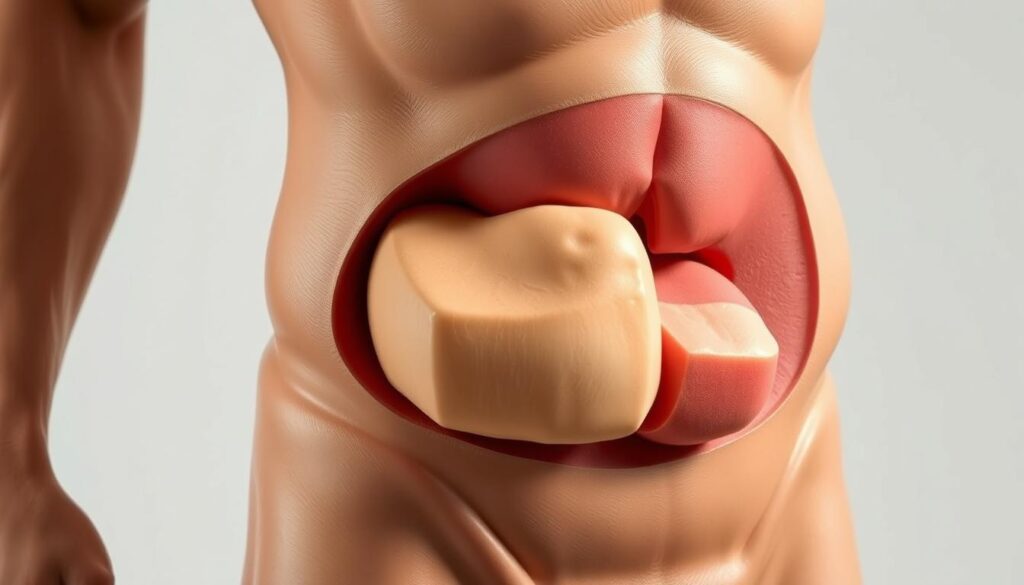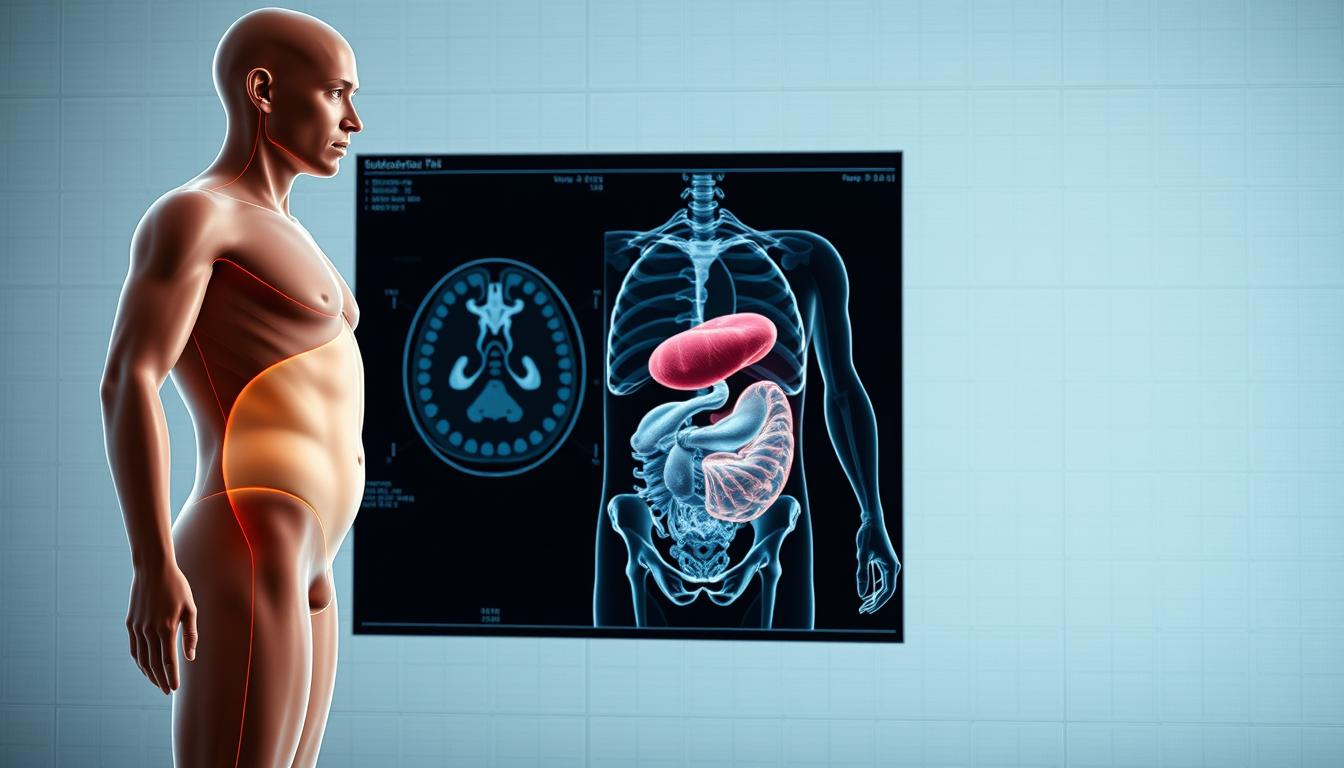Most people track their weight religiously, but numbers alone don’t reveal the full story. What if two people share the same body mass yet face wildly different health risks? The answer lies in where fat accumulates – and why some types matter far more than others.
Our bodies store body fat in two distinct ways. The soft layer beneath your skin (subcutaneous) acts as energy storage. Meanwhile, visceral fat wraps around vital organs, releasing compounds that disrupt metabolism. Research from the Cleveland Clinic shows this hidden fat dramatically increases risks for heart disease and diabetes, even in seemingly healthy individuals.
We’ll break down practical ways to assess both types, from basic tape measurements to advanced imaging. You’ll discover why tracking body fat distribution trumps obsessing over pounds. Recent studies highlighted by Business Insider confirm that visceral reduction strategies improve metabolic health faster than generic weight loss approaches.
Key Takeaways
- Not all fat is created equal – location determines health impact
- Visceral fat poses higher risks than subcutaneous deposits
- Multiple assessment methods exist beyond standard BMI calculations
- Tracking changes helps optimize wellness strategies
- Medical-grade insights don’t require lab visits
Introduction to the Importance of Measuring Body Fat
Weight fluctuations tell part of the story, but true health insights come from analyzing fat placement. Simple tools like tape measures and BMI calculations reveal patterns that scales miss entirely.

Essential Assessment Tools
Three accessible methods help identify risks:
| Method | Ease of Use | Accuracy | Best For |
|---|---|---|---|
| BMI Calculation | High | Moderate | General screening |
| Waist Measurement | Very High | High | Visceral fat detection |
| Smart Scales | Medium | Variable | Trend tracking |
| Skinfold Calipers | Low | Expert-dependent | Targeted analysis |
Decoding the Numbers
A waist circumference over 35″ (women) or 40″ (men) often signals dangerous visceral accumulation. Combined with elevated BMI scores, these metrics help predict diabetes risk 3-5 years before symptoms appear.
Regular tracking creates accountability. When exercise routines reduce waist size by just 2%, metabolic improvements follow. This approach works better than chasing arbitrary weight targets.
Understanding the Differences: Subcutaneous vs. Visceral Fat
Not all body fat impacts health the same way. Where it settles – beneath your skin or around organs – determines whether it’s mostly harmless or a silent threat.

Defining Subcutaneous Fat
The soft layer padding your thighs and abdomen is subcutaneous fat. Stored between muscles and skin, it serves as energy reserves. While excess amounts affect body size, this type generally poses fewer direct health risks.
Skinfold calipers estimate these deposits by measuring pinchable folds. A reading over 25mm at triceps or abdomen suggests higher levels. However, this method doesn’t assess deeper fat layers.
Explaining Visceral Fat and Its Risks
Visceral fat accumulates around liver, pancreas, and intestines. Unlike subcutaneous stores, it actively releases inflammatory chemicals. These compounds increase heart disease risk by 48% according to Cleveland Clinic research.
Body composition plays a key role. Individuals with apple-shaped body types often have more visceral deposits. Even people with normal BMI versus visceral fat percentage readings can harbor dangerous amounts.
Persistent inflammation from this deep fat drives insulin resistance and diabetes. Studies link waist-to-height ratios above 0.5 to doubled cardiovascular disease risks. Monitoring these metrics helps catch issues before symptoms emerge.
How to measure subcutaneous fat vs. visceral fat
Tracking your progress requires more than just numbers on a scale. Simple tools and consistent habits reveal whether you’re trimming dangerous internal deposits or just shedding water weight.
Step-by-Step Overview of Measurement Methods
For subcutaneous deposits, use skinfold calipers on three key areas:
- Pinch the skin 1 inch above your right hipbone
- Measure the fold midway between shoulder and elbow
- Check the area 2 inches below your shoulder blade
A tape measure exposes visceral risks better than most gadgets. Wrap it around your bare waist at navel level after exhaling. Record weekly changes – even ¼ inch reductions signal metabolic improvements.
Consistency matters. Always check at the same time of day, ideally before meals. Pair these methods with photos to visualize shifts that numbers alone can’t show.
Those aiming to lose visceral stores should track waist size first. Research shows reducing this area by 5% lowers diabetes risk by 15%. Combine measurements with blood pressure checks for a complete health snapshot.
Smart scales help monitor trends, but don’t rely solely on their estimates. Manual methods provide tangible feedback that keeps motivation high during weight management journeys.
Practical Methods and Tools for Measuring Body Fat
Accurate body composition tracking starts with choosing the right tools. While scales show overall changes, combining methods reveals what’s happening beneath the surface. We’ll explore cost-effective strategies that fit daily routines while delivering actionable insights.
Using Scales, Tape Measures, and BMI Calculations
Basic tools provide surprising depth when used consistently. Track waist size at the narrowest point and hips at the widest – ratios above 0.85 (women) or 0.9 (men) indicate higher health risks. Pair these with better than BMI metrics like waist-to-height ratios for clearer risk stratification.
| Method | Cost | Best Use | Key Factors |
|---|---|---|---|
| Tape Measure | $5-$15 | Tracking visceral fat trends | Consistent morning measurements |
| BMI Calculator | Free | Initial risk screening | Doesn’t account for muscle mass |
| Digital Scale | $30-$100 | Daily weight trends | Hydration levels affect accuracy |
Utilizing Skinfold Calipers and Smart Scales
Skinfold calipers ($10-$50) measure pinchable fat at triceps, thighs, and suprailiac areas. Three consecutive readings averaged together improve accuracy. “Manual measurements build awareness that apps can’t replicate,” notes a Johns Hopkins fitness study.
Smart scales estimate mass index using bioelectrical impedance. For consistent results:
- Weigh at the same time daily
- Avoid measurements after intense workouts
- Pair with blood pressure checks for full metabolic insights
Apple-shaped body shapes often need tighter waist monitoring, while pear shapes focus on hip ratios. Remember: Devices have margins of error – trends matter more than single data points.
Lab Techniques for Precise Body Fat Assessment
Medical-grade body composition analysis reveals hidden risks that home tools miss. Advanced lab methods pinpoint fat distribution around vital organs and provide actionable health insights unavailable through basic measurements.
DEXA Scans and Their Application
Dual-energy X-ray absorptiometry (DEXA) scans use low-radiation beams to separate body mass into fat, muscle, and bone components. Cleveland Clinic studies show this method detects dangerous fat deposits near the liver and pancreas with 98% accuracy – critical for assessing diabetes risks.
Underwater Weighing and Air Displacement Methods
Hydrostatic weighing calculates body density by comparing land and water weights. The BOD POD® system uses air displacement technology instead, making it faster and more accessible. Both methods help identify fat percentages linked to cardiovascular problems.
| Method | Procedure | Accuracy | Best Use | Cost |
|---|---|---|---|---|
| DEXA | 10-min scan | ±1.5% | Organ fat analysis | $100-$250 |
| BOD POD | 5-min test | ±2% | Overall fat % | $50-$75 |
| Hydrostatic | Water submersion | ±1.8% | Research settings | $150-$300 |
Blood tests complement these techniques by measuring triglycerides and insulin resistance index levels. Elevated markers often correlate with visceral fat around organs, even in individuals with normal BMIs.
While lab methods outperform home measurements, they’re not perfect. DEXA can’t distinguish between visceral and subcutaneous fat layers. BOD POD results fluctuate with lung capacity. Still, these tests remain the gold standard for catching early-stage metabolic problems before blood sugar issues escalate.
Insurance rarely covers these assessments without documented health concerns. For high-risk patients, combining annual DEXA scans with quarterly blood work creates a powerful prevention strategy against diabetes and heart disease.
Health Implications and Considerations in Fat Measurement
Where your body stores excess fat determines more than just clothing sizes—it dictates critical health outcomes. Research confirms that distribution patterns directly correlate with heart disease likelihood and metabolic complications. Recognizing warning signs in measurement data helps prevent severe health problems before they escalate.
Cardiovascular Risks and Metabolic Red Flags
Visceral fat acts like an endocrine organ, pumping inflammatory chemicals into the bloodstream. Cleveland Clinic studies show individuals with waist sizes exceeding 40″ (men) or 35″ (women) face 72% higher heart attack risks. These deposits also impair insulin function, doubling diabetes susceptibility.
| Risk Factor | Men | Women | Critical Sign |
|---|---|---|---|
| Waist Circumference | >40″ | >35″ | Visceral fat threshold |
| Triglyceride Levels | >150 mg/dL | >150 mg/dL | Metabolic syndrome marker |
| Blood Pressure | >130/85 mmHg | >130/85 mmHg | Cardiovascular strain |
Turning Data Into Action
Timing affects readings drastically. Measuring your waist two minutes after eating versus fasting can skew results by 1.5 inches. Consistency matters—always check at the same time daily using standardized techniques.
Men often show earlier warning signs than women. A 2023 Johns Hopkins study found males with waist-to-height ratios above 0.55 developed heart issues 8 years sooner. Pair measurements with bloodwork for complete insights.
- Track trends weekly, not daily
- Combine waist data with HDL cholesterol levels
- Adjust exercise plans if measurements plateau
Understanding these patterns helps create targeted interventions. Reducing visceral fat by just 10% lowers heart disease risk by 33%—a lifesaving difference hidden in routine measurements.
Conclusion
Understanding where your body stores energy reserves changes everything about health management. Our exploration reveals that simple tape measurements and advanced scans both play vital roles in assessing risks. Studies from Cleveland Clinic and Business Insider confirm that tracking these deposits leads to smarter lifestyle choices.
Consistency matters most. Whether using at-home tools or lab tests, regular monitoring helps spot dangerous trends early. Those who pair waist measurements with professional guidance see faster improvements in metabolic health.
Prioritizing body fat distribution over scale numbers reduces long-term health risks. Start with one method – a tape measure or smart scale – and build from there. Remember: Knowledge about your unique patterns empowers better decisions, from exercise plans to dietary adjustments.
Consult healthcare providers to interpret results accurately. Small, consistent changes guided by this data can dramatically lower cardiovascular and diabetes risks. Your body’s hidden signals hold the key to lasting wellness.

